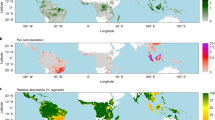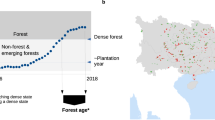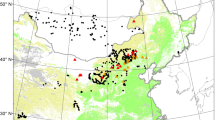Abstract
Southeast Asia is a hotspot of tropical deforestation for agriculture. Most of the deforestation is thought to occur in lowland forests, whereas the region’s mountainous highlands undergo very limited deforestation. However, regional reports of cropland expansion in some highland areas suggest that this assumption is inaccurate. Here we investigate patterns of forest change and cropland expansion in the region for the twenty-first century, based on multiple streams of state-of-the-art satellite imagery. We find large increases in cultivated areas that have not been documented or projected. Many of these cultivated areas have evolved from forests that vary in health and status, including primary and protected forests, or from recovering lands that were on a trajectory to become secondary forests. These areas all have different biophysical features than croplands. We estimate that an area of 82 billion m2 has been developed into croplands in the Southeast Asian highlands. Some portion of this land-use change is probably attributable to agricultural intensification on formerly swidden agriculture lands; however, a substantial proportion is from new forest loss. Our findings are in marked contrast with projections of land-cover trends that currently inform the prediction of future climate change, terrestrial carbon storage, biomass, biodiversity, and land degradation.
This is a preview of subscription content, access via your institution
Access options
Access Nature and 54 other Nature Portfolio journals
Get Nature+, our best-value online-access subscription
$29.99 / 30 days
cancel any time
Subscribe to this journal
Receive 12 print issues and online access
$259.00 per year
only $21.58 per issue
Buy this article
- Purchase on Springer Link
- Instant access to full article PDF
Prices may be subject to local taxes which are calculated during checkout




Similar content being viewed by others
References
IPCC Climate Change 2013: The Physical Science Basis (eds Stocker, T. F. et al.) (Cambridge Univ. Press, 2013).
Feddema, J. et al. The importance of land-cover change in simulating future climates. Science 310, 1674–1678 (2005).
Zeng, Z. et al. Climate mitigation from vegetation biophysical feedbacks during the past three decades. Nat. Clim. Change 7, 432–436 (2017).
Zeng, Z. et al. Impact of Earth greening on the terrestrial water cycle. J. Clim. 31, 2633–2650 (2018).
Alkama, R. & Cescatti, A. Biophysical climate impacts of recent changes in global forest cover. Science 351, 600–604 (2016).
Crist, E. et al. The interaction of human population, food production, and biodiversity protection. Science 356, 260–264 (2017).
Lawrence, D. & Vandecar, K. Effects of tropical deforestation on climate and agriculture. Nat. Clim. Change 5, 27–36 (2015).
Wilcove, D. et al. Navjot’s nightmare revisited: logging, agriculture, and biodiversity in Southeast Asia. Trends Ecol. Evol. 28, 531–540 (2013).
Curran, L. et al. Lowland forest loss in protected areas of Indonesian Borneo. Science 303, 1000–1003 (2004).
Margono, B. et al. Primary forest cover loss in Indonesia over 2000-2012. Nat. Clim. Change 4, 730–735 (2014).
Achard, F. et al. Determination of deforestation rates of the world humid tropical forests. Science 297, 999–1002 (2002).
Kim, D. et al. Accelerated deforestation in the humid tropics from the 1990s to the 2000s. Geophys. Res. Lett. 42, 3495–3501 (2015).
Tomich, T., Thomas, D. & van Noordwijk, M. Environmental services and land use change in Southeast Asia: from recognition to regulation or reward? Agric. Ecosyst. Environ. 104, 229–244 (2004).
Pan, Y. et al. A large and persistent carbon sink in the world’s forests. Science 333, 988–993 (2011).
Valentin, C. et al. Runoff and sediment losses from 27 upland catchments in Southeast Asia: impact of rapid land use changes and conservation practices. Agric. Ecosyst. Environ. 128, 225–238 (2008).
Ahrends, A. et al. Current trends of rubber plantation expansion may threaten biodiversity and livelihoods. Glob. Environ. Change 34, 48–58 (2015).
Hurni, K. et al. Mapping the expansion of boom crops in Mainland Southeast Asia using dense time stacks of Landsat data. Remote Sens. 9, 320–346 (2017).
Fox, J. et al. Expansion of rubber mono-cropping and its implications for the resilience of ecosystems in the face of climate change in Montane Mainland Southeast Asia. Glob. Environ. Change 29, 318–326 (2014).
Fox, F. et al. Simulating land-cover change in Montane Mainland Southeast Asia. Environ. Manag. 49, 968–979 (2012).
Alexandratos, N. & Bruinsma, J. World Agriculture Towards 2030/2050: The 2012 Revision Working Paper No. 12-03 (FAO, 2012). .
Pongkijvorasin, S. & Teerasuwannajak, K. in Sustainable Economic Development (eds Balisacan, A. M. et al.) 105–122 (Academic Press, San Diego, 2015).
Kitchaicharoen, J. et al. Situational Analysis in Support of The Development of Integrated Agricultural Systems in the Upland Areas of Nan Province (Humidtropics, 2015).
Peng, W. et al. Research on soil quality change after returning farmland to forest on the loess sloping croplands. J. Nat. Resour. 20, 272–278 (2005).
Cuo, L. et al. The roles of roads and agricultural land use in altering hydrological processes in Nam Mae Rim watershed, northern Thailand. Hydrol. Process. 22, 4339–4354 (2008).
Pielke, R. & Avissar, R. Influence of landscape structure on local and regional climate. Landsc. Ecol. 4, 133–155 (1990).
Wilson, A. & Barros, A. Orographic land–atmosphere interactions and the diurnal cycle of low-level clouds and fog. J. Hydrometeorol. 18, 1513–1533 (2017).
Xue, Y. & Dirmeyer, P. Land-atmosphere interactions in monsoon regimes and future prospects for enhancing prediction. CLIVAR Exch. 19, 28–32 (2015).
Hansen, M. et al. High-resolution global maps of 21st-century forest cover change. Science 342, 850–853 (2013).
Stibig, H. et al. Change in tropical forest cover of Southeast Asia from 1990 to 2010. Biogeosciences 11, 247–258 (2014).
Hansen, M. et al. Response to comment on “High-resolution global maps of 21st-century forest cover change”. Science 344, 981 (2014).
Olofsson, P. et al. Good practices for estimating area and assessing accuracy of land change. Remote Sens. Environ. 148, 42–57 (2014).
Hurtt, G. et al. Harmonization of land-use scenarios for the period 1500–2100: 600 years of global gridded annual land-use transitions, wood harvest, and resulting secondary lands. Climatic Change 109, 117–161 (2011).
Friedl, A. et al. MODIS Collection 5 Global Land Cover: Algorithm Refinements and Characterization of New Datasets, 2001-2012 Collection 5.1 (Boston University, Boston, 2010); ftp://ftp.glcf.umd.edu/glcf/Global_LNDCVR/UMD_TILES
Land Cover CCI: Product User Guide Version 2 (ESA, 2017); http://maps.elie.ucl.ac.be/CCI/viewer/download/ESACCI-LC-Ph2-PUGv2_2.0.pdf
Chen, J. et al. Global land cover mapping at 30 m resolution: a POK-based operational approach. ISPRS J. Photogramm. Remote Sens. 103, 7–27 (2015).
Scott, J. The Art of Not Being Governed: An Anarchist History of Upland Southeast Asia (Yale Univ. Press, New Haven, 2014).
Stephen, S. Estimating area and map accuracy for stratified random sampling when the strata are different from the map classes. Int. J. Remote Sens. 35, 4923–4939 (2014).
Bruun, T. et al. Environmental consequences of the demise in swidden cultivation in Southeast Asia: Carbon storage and soil quality. Hum. Ecol. 37, 375–388 (2009).
Bruun, T. et al. Intensification of upland agriculture in Thailand: development or degradation? Land Degrad. Dev. 28, 83–94 (2017).
Schmidt-Vogt, D. et al. An assessment of trends in the extent of swidden in Southeast Asia. Hum. Ecol. 37, 269–280 (2009).
Ozdogan, M. & Woodcock, C. Resolution dependent errors in remote sensing of cultivated areas. Remote Sens. Environ. 103, 203–217 (2006).
Suksawang, S. & McNeely, J. Parks for Life: Why We Love Thailand's National Parks (Clung Wicha, Nonthaburi, 2015).
Lakanavichian, S. in Forest Out of Bounds: Impacts and Effectiveness of Logging Bans in Natural Forests in Asia-Pacific (eds Durst, P. B. et al.) 167–184 (FAO, 2001).
Aide, T. et al. Deforestation and reforestation of Latin America and the Caribbean (2001–2010). Biotropica 45, 262–271 (2013).
Byerlee, D. et al. Does intensification slow crop land expansion or encourage deforestation? Glob. Food Secur. 3, 92–98 (2014).
Fox, J. & Vogler, J. Land-use and land-cover change in montane Mainland Southeast Asia. Environ. Manage. 36, 394–403 (2005).
Sidle, R. & Ziegler, A. The dilemma of mountain roads. Nat. Geosci. 5, 437–438 (2012).
Zarin, D. et al. Can carbon emissions from tropical deforestation drop by 50% in five years? Glob. Change Biol. 22, 1336–1347 (2016).
Estes, L. et al. A platform for crowdsourcing the creation of representative, accurate landcover maps. Environ. Modell. Softw. 80, 41–53 (2016).
Chini, L., Hurtt, G. & Frolking, S. Harmonized Global Land Use for Years 1500-2100 V1 (Oak Ridge National Laboratory Distributed Active Archive Center, 2014); https://doi.org/10.3334/ORNLDAAC/1248
Acknowledgements
This study was supported by Lamsam-Thailand Sustain Development (B0891). We thank Della Research Computing in Princeton University for providing computing resources. We thank CMIP for providing the IPCC global land-cover change forcing; J. Chen, D.-H. Kim and Hansen/UMD/Google/USGS/NASA for providing the moderate- and high-resolution satellite land-use/cover products; the Planet Lab and Google Earth for providing high-resolution satellite imagery; and the KASIKORN Foundation for data collection in the Nan province, Thailand. We also thank M. Pan and D. Gower for useful comments.
Author information
Authors and Affiliations
Contributions
Z.Z. and E.F.W. designed the research. Z.Z. performed analysis. Z.Z., L.E. and A.D.Z. wrote the draft, and all authors contributed to the interpretation of the results and writing of the paper.
Corresponding author
Ethics declarations
Competing interests
The authors declare no competing interests.
Additional information
Publisher’s note: Springer Nature remains neutral with regard to jurisdictional claims in published maps and institutional affiliations.
Supplementary information
Supplementary Information
Supplementary Figures and Tables
Supplementary Data
Supplementary Data Set
Rights and permissions
About this article
Cite this article
Zeng, Z., Estes, L., Ziegler, A.D. et al. Highland cropland expansion and forest loss in Southeast Asia in the twenty-first century. Nature Geosci 11, 556–562 (2018). https://doi.org/10.1038/s41561-018-0166-9
Received:
Accepted:
Published:
Issue Date:
DOI: https://doi.org/10.1038/s41561-018-0166-9
This article is cited by
-
A dataset for soil organic carbon in agricultural systems for the Southeast Asia region
Scientific Data (2024)
-
Mapping the diversity of land uses following deforestation across Africa
Scientific Reports (2024)
-
Long-term land transformation alters potential ecological corridors and increases functional connectivity cost among nature reserves in Guangdong, China
Landscape and Ecological Engineering (2024)
-
Long-Term Effects of Ecological Restoration Projects on Ecosystem Services and Their Spatial Interactions: A Case Study of Hainan Tropical Forest Park in China
Environmental Management (2024)
-
How effective are perches in promoting bird-mediated seed dispersal for natural forest regeneration? A systematic review protocol
Environmental Evidence (2023)



